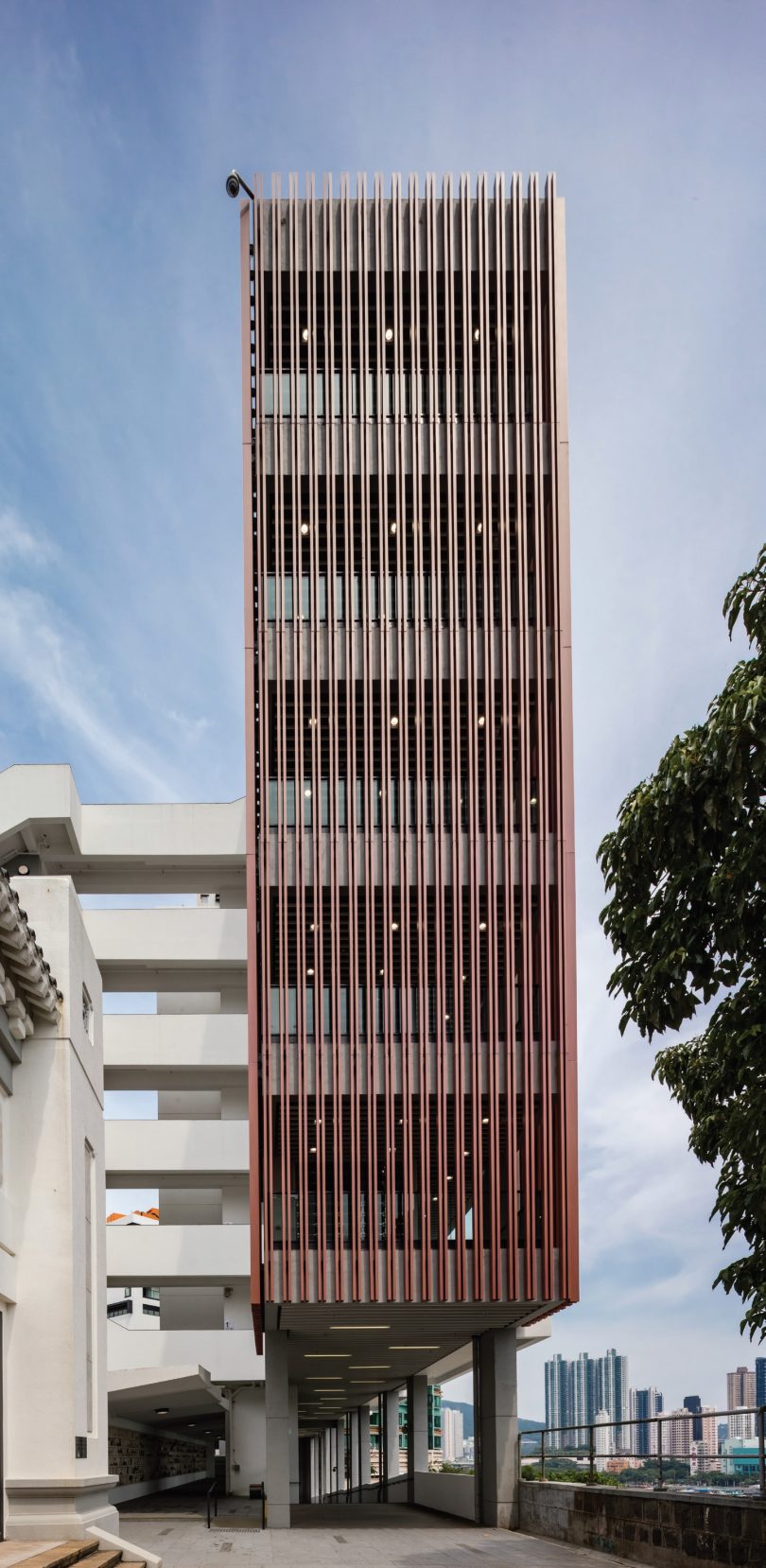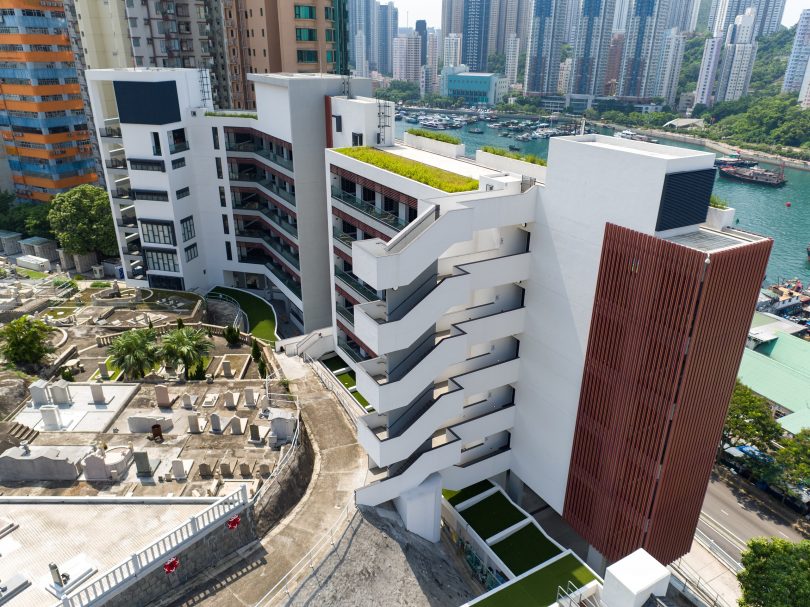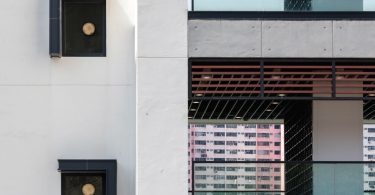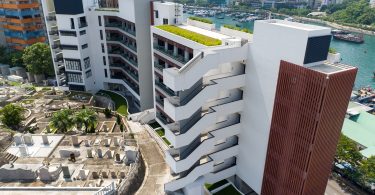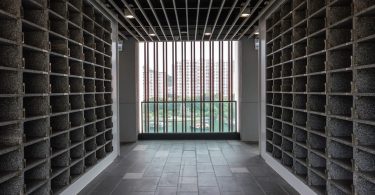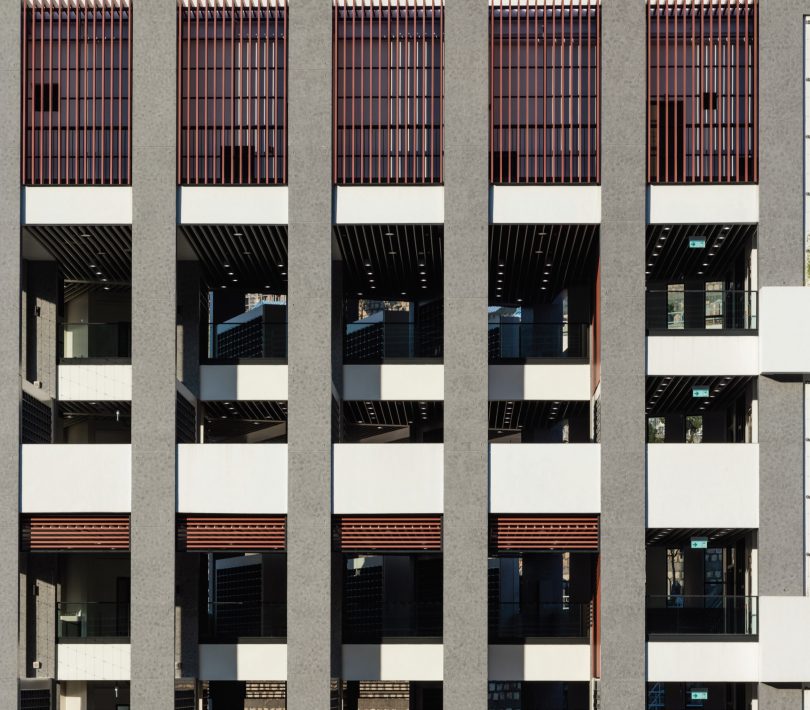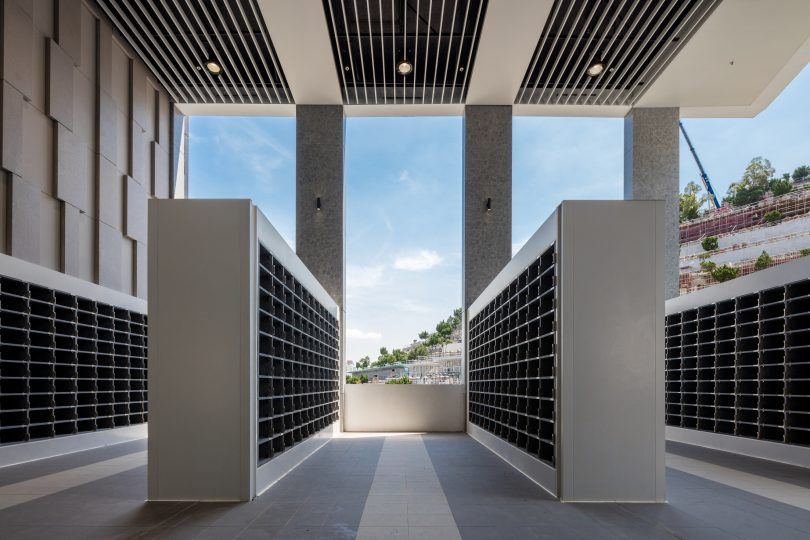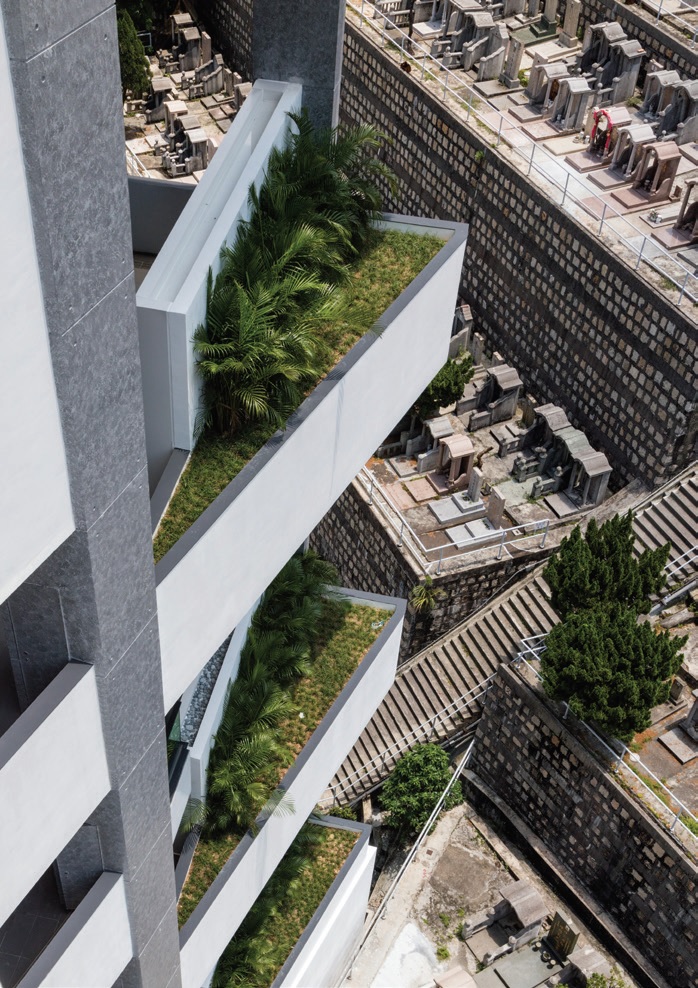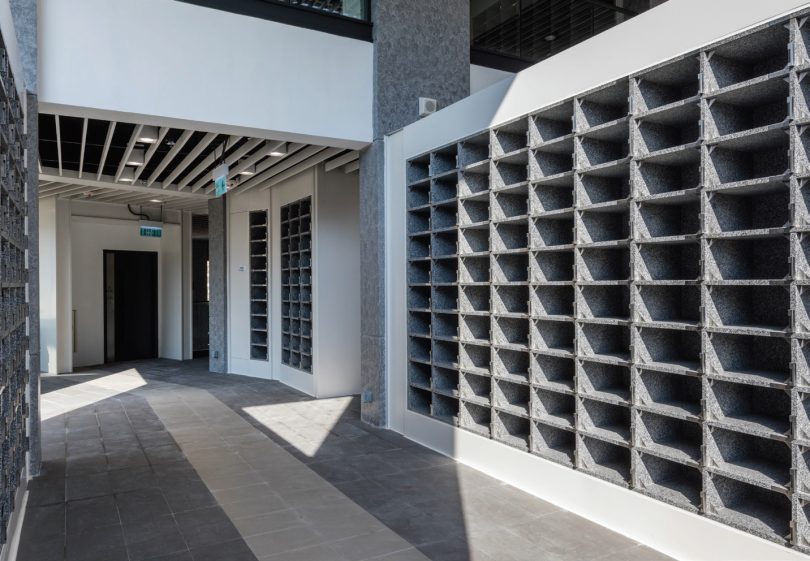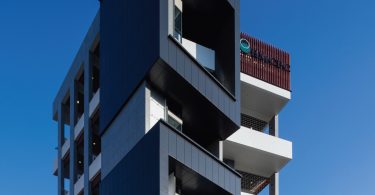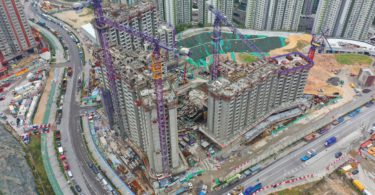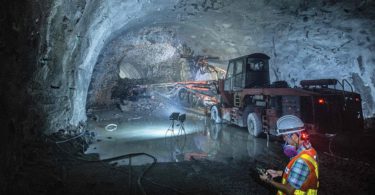With a growing and ageing population in Hong Kong, the number of cremations has been rising gradually every year, resulting in an increasing demand for public niches. In view of the shortage of niche facilities, the Board of Management of the Chinese Permanent Cemeteries (BMCPC)—a non-profit organisation that operates four cemeteries in Aberdeen, Cape Collinson (Chai Wan), Junk Bay and Tsuen Wan—required two new columbaria at its Aberdeen and Cape Collinson cemeteries.
Columbaria are usually perceived to be unattractive concrete buildings with minimal architectural finishes. In these two projects, the architect challenged the standard and altered people’s perceptions of a columbarium by designing buildings that are modern, attractive and Green. There are solemn niche areas for paying respects to those who passed away, as well as landscaped breakout spaces at the perimeter the building for visitors to gather and interact. A range of materials were utilised in the buildings to create a variety of internal spaces and diversity in the building façade for the enjoyment of the public.
ABERDEEN CHINESE PERMANENT CEMETERY
The new six-storey columbarium constructed in the existing Aberdeen Chinese Permanent Cemetery provides approximately 15,300 additional niches, as well as an administrative office and amenities. It is built on a long and narrow site with existing columbaria to the north and west, and several highway slopes to the south.
The majority of the new building was elevated over the existing access road to maximise the use of the site’s limited space. It was imperative to keep the access road that connects to the adjacent existing columbaria. By elevating the building above the access road, the cemetery was able to operate normally with the existence of the new columbarium. It also ensured that the impacts on the existing columbaria were minimal, and any physical and visual obstructions were diminished as far as possible. This design also made the ground floor area available for use as breakout spaces for people to gather and interact.
Many residential buildings have been built in the neighbouring areas, with a few even in very close proximity the new columbarium. The elevated columbarium acts as an attractive screen to hide the unpleasant views of the grave terraces.
GREEN FEATURES
In consideration of the residential buildings beside the new columbarium, an analysis was carried out to reduce the visual impact of the new building. The vertical grille features on the building façade and the soft landscaping in planter areas were carefully designed to control views into the building. Climber plants covering the vertical green walls effectively conceal the niches within the Columbarium. Also, a roof garden was created to help the building blend in with the surrounding natural environment.
The long yet narrow form of the building permitted the use of natural daylighting and cross ventilation within the interior areas. The arrangement of the rows of niches within the columbarium was kept simple, while the orientations were arranged to maximise the penetration of natural daylighting. Energy-efficient fittings and equipment were installed to further increase the environmentally friendly aspects of the building.
Although there were only a few trees within the existing site and the land lease did not require any trees to be transplanted or compensated, it was desired by both the client and the architect to increase the greenery within the cemetery. Thus, most of the existing trees were transplanted to other areas in the cemetery as well as within the new building.
MATERIALS
The new columbarium is over 100 metres long and less than 30 metres high. The architect employed different elevational treatments to break the long façade into smaller segments. The core concrete structures have a raw concrete finish, while the façade walls were painted white. A warm red-brown colour was selected for the grilles, while glass balustrades were installed in the receding areas to maximise the natural daylight entering the building.
A fair-faced concrete coating system was applied to create the raw concrete finishes of the building façade and columns in order to better control the quality of the final concrete finish and the duration of the construction. Linear recesses were added to the fair-faced concrete surfaces to further break the long column and façade into smaller divisions. Circular recesses similar to the ones inherent in real fair-faced concrete were incorporated to further enhance the character of the finish.
Initially, natural timber was intended for the grilles but due to foreseeable difficulties in obtaining approval for a non-combustible material, an alternative product that had similar appearance was sourced. In the end, aluminium hollows covered with timber-patterned film were used for the grille features. These grilles withstand exposure to adverse weather and maintain their straight appearance for a long time.
The niche blocks of the columbarium were constructed using natural granite stone. As for the niches, white-based stone with dark grey mineral grains was chosen because it complements the simple design of the columbarium.
Location: Peel Rise, Aberdeen Chinese Permanent Cemetery, Hong Kong
Completion Date: March 2016
Site Area: 1,750 square metres (notional)
Gross Floor Area: 4,885 square metres
Building Height: 6 storeys
Client/Owner: The Board of Management of the Chinese Permanent Cemeteries (BMCPC)
Architecture Firm: Spence Robinson Limited
Principal Architects: Yuen Kwok Cheung; Mango Yu
Main Contractor: Tai Dou Building Contractor
Mechanical & Electrical Engineer: David S.K. Au & Associates Ltd.
Civil & Structural Engineer: Hyder Consulting Limited
Landscape Architect: Constance Design Studio Limited
Images/Photos: Winnie Yeung @ iMAGE28
CAPE COLLINSON CHINESE PERMANENT CEMETERY
At Cape Collinson Chinese Permanent Cemetery, a nine-storey columbarium building was built to provide approximately 10,000 new niches, as well as associated facilities such as an administrative office and loading/unloading area.
CHALLENGES
The proposed site was at the bottom of a steep slope formed by grave terraces, with Cape Collinson Road on the north-west and Lin Shing Road on the southwest. This was a major design challenge as the building needed to act as a retaining structure for the slope. As a solution, shallow foundations were constructed because they are quick and not too expensive to build. Another constraint in this project was the existing 1,520-millimetre diameter stormwater pipe running through a major portion of the site. The pipe needed to be permanently diverted prior to the commencement of substructure works for the new building. This was a critical item in the design, which required thorough planning of construction works was necessary to shorten the duration of construction. It was through the detailed phasing of substructure construction works and scheduling for other works to operate concurrently that the whole construction was able to proceed smoothly.
GREEN ROOF AND WALLS
The site’s compact and irregular form allowed for opportunities to introduce soft landscaped areas and draw the nature of the surrounding areas into the building. Small shrubs and bamboo screens were installed in the planter areas, while climber plants covered the vertical greening walls. A green roof was created which further integrated the building with the surrounding natural environment.
The existing trees at the outdoor seating area were removed in order to facilitate the construction of the new columbarium. Although the land lease did not stipulate tree transplanting or compensation clauses, BMCPC voluntarily compensated the felled trees within the same cemetery. Also, one tree was transplanted to a new planter adjacent to the columbarium building.
ENVIRONMENTALLY FRIENDLY MATERIALS
To further enhance the environmentally friendly aspects of the project, natural materials were desired to finish the building. However, due to constraints such as cost, availability and regulatory issues, alternative proposals were sourced for some materials.
Red and yellow tinged granite stones were selected for the internal and exterior areas of the ground floor because of their natural earthy tones and colour contrast with the greys of the surrounding footpaths and roads. On the other hand, speckled grey stones were used for the individual niche to present a more reserved setting suitable for the placement of urns and stone plaques.
A natural fair-faced concrete finish was envisioned for the columns of the building and portions of the external façade. However, there are not many successful precedents of using natural fair-faced concrete finish in construction in Hong Kong due to the humid weather. To better control the quality and shorten the time of construction, a coating system that imitates the appearance of fair-faced concrete was selected. It was not only able to imitate the appearance of raw concrete in a smooth finish but also replicate the grain lines of timber planks. The finish is not only realistic but adds to the character of the building.
Natural timber was originally intended for the vertical grille features on the external façade. However, as it is difficult to obtain building code approval for timber due to non-combustibility issues, aluminium hollows covered with timber-patterned film were used instead.
NATURAL LIGHTING
Due to the building’s height and the sloped grave terrace to the rear of the site, it was difficult for natural daylighting to reach the lower levels of the building. As a solution, double storey spaces were incorporated at the building’s perimeter on alternating façades to bring in sunlight and enhance the spatial quality of the internal areas. Energy-saving equipment and fittings were installed wherever possible.
Location: Cape Collinson Chinese Permanent Cemetery, Cape Collinson Road, Hong Kong
Completion Date: May 2016
Site Area: 800 square metres (notional)
Gross Floor Area: 3,785 square metres
Building Height: 9 storeys
Client/Owner: The Board of Management of the Chinese Permanent Cemeteries (BMCPC)
Architecture Firm: Spence Robinson Limited
Principal Architects: Yuen Kwok Cheung; Mango Yu
Main Contractor: Wide Project Engineering & Construction Company
Mechanical & Electrical Engineer: David S.K. Au & Associates Ltd.
Civil & Structural Engineer: Hyder Consulting Limited
Landscape Architect: ACLA Limited
Images/Photos: Winnie Yeung @ iMAGE28

 Malaysia
Malaysia Singapore
Singapore Indonesia
Indonesia Tiếng Việt
Tiếng Việt ประเทศไทย
ประเทศไทย



